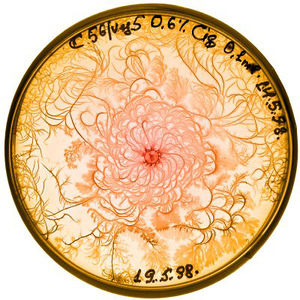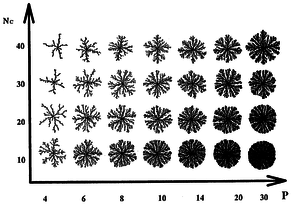Patterns of Bacterial Growth: Difference between revisions
No edit summary |
|||
| Line 26: | Line 26: | ||
==Nutrient Density== | ==Nutrient Density== | ||
Bacterial growth patterns are compact at high nutrient densities, and become more fractals and peptone density decreases. | |||
==Intercellular Communication== | ==Intercellular Communication== | ||
Revision as of 21:17, 2 December 2013
Introduction
For the purposes of identifying patterns of growth, bacteria colonies can be through of as multicellular organisms. (info about communication)
Patterns of growth are a result of bacteria adapting their behavior to suit their environment.
Bacteria in the lab are grown specifically to isolate single colonies. Bacteria in the wild must cope with environmental conditions.
Diffusion-Limited Aggregation

Diffusion-Limited Aggregation (DLA) is a growth model that results in complex, multi-branched forms. It can be applied to any system where diffusion is the main method of particle transportation. It can be observed in bacterial growth on agar plates, dendrites, dust balls, electrodeposition, and mineral deposits.
To form a DLA pattern, begin with a seed molecule at the origin of the lattice. A "random walker" molecule diffuses from far away in a random pattern of motion. It stops once it reaches a space adjacent to the seed molecule, and another random walker is launched. In a DLA lattice, a molecule that sticks out of a main branch will not be rounded or smoothed over by new growth, but rather emphasized. Nodes are more likely to catch wandering particles because they three facets available for growth, compared to a molecule in the branch, which only has one facet.
Agar Density
Include some current research, with at least one image.
Nutrient Density
Bacterial growth patterns are compact at high nutrient densities, and become more fractals and peptone density decreases.
Intercellular Communication
Conclusion
Overall text length should be at least 1,000 words (before counting references), with at least 2 images. Include at least 5 references under Reference section.
References
Edited by Eleanor Lopatto, student of Joan Slonczewski for BIOL 116 Information in Living Systems, 2013, Kenyon College.


